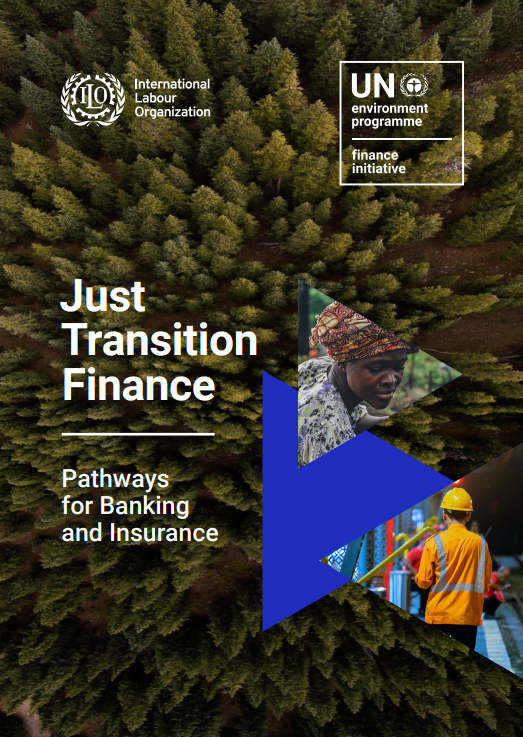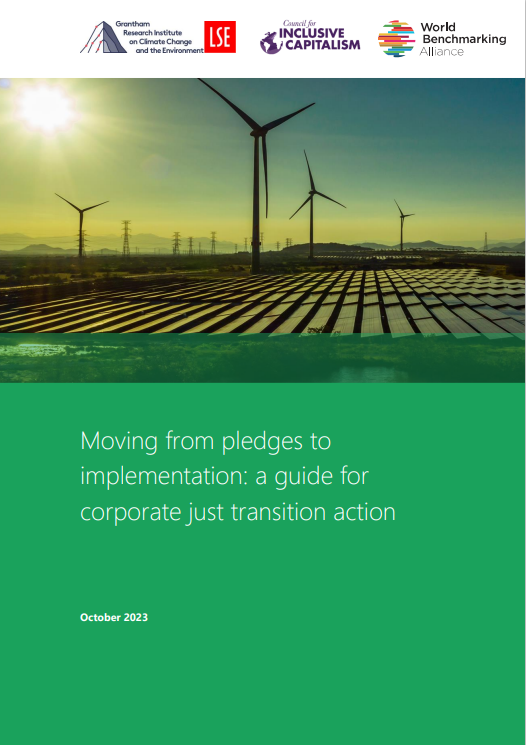
A just transition is key to ambitious climate action and the finance sector plays a major role in enabling the shift to low-carbon and inclusive economies. The Just Transition Finance – Pathways for Banking and Insurance report by the International Labour Organization (ILO) and the United Nations Environment Programme Finance Initiative (UNEP FI), published in December 2023, proposes a rationale and a blueprint for banks and insurance companies wishing to embrace a just transition.
Here are nine key approaches to cohesively integrate both environmental and social factors into the strategies and core business operations of financial institutions and drive sustainable change.
1. Commit to a just transition
Secure buy-in from senior management. The organisation’s commitment to a just energy transition should be robust and approved by top-level leaders. This will send clear signals within and well beyond the organisation: a just transition is a priority.
2. Understand just transition and its implications
Assess social risks and impacts arising from the green transition. By mapping the common transition dynamics and recognising the impacts, financial institutions are more prepared to face the challenges and capitalise on opportunities. National and regional transition plans are a valuable resource for understanding the local needs of a just transition.
3. Prioritise people in strategy and decision-making
Considering perspectives of all relevant stakeholders is key to garnering broad-based support for climate action. Without inclusive processes encompassing all relevant stakeholders, equitable outcomes cannot be achieved.
Financial institutions can benefit from the knowledge of stakeholders to build an effective just transition-aligned strategy encompassing various perspectives. Furthermore, they can use their influence to encourage the adoption of inclusive practices within their ecosystem, including clients, investees, service providers, and partners.
4. Set out an implementation strategy
Make sure that the just transition commitment is well-reflected in institutional strategies, policies, and processes and that institutional capacity is available.
5. Develop well-aimed products for financing and protection needs
To offer adapted solutions, banks and insurance companies must identify the needs of the affected entities and groups and tailor products to support local economies in impacted regions. They must promote investment in green technologies and climate resilience, endorse enabling activities and business models, and help manage climate impacts as well as transition risks.
Innovative products can help incentivise environmentally and socially responsible choices. Insurers, for example, can offer more favorable premium rates to clients who take steps to transform their activities with high social or environmental risks.
6. Improve financial inclusion and bridge protection gap
To make sure that the benefits of the climate transition are shared broadly, green finance solutions should be available and designed to meet the needs of vulnerable populations and the groups impacted by the transition. Low-income customers are often underserved, while access to financial and insurance solutions is crucial to boost resilience, improve financial stability, and maintain the livelihoods of vulnerable customers.
7. Manage client-specific social impacts, risks, and opportunities
While actively investing in the green economy transition, it is crucial to make sure that social risks and impacts are not overlooked and that addressing one sustainability challenge does not create or exacerbate another. Financial institutions’ risk management processes enable the identification and management of client or project-specific risks and opportunities, including potential social and employment impacts. It is crucial to monitor progress and engage with clients to effectively respond to evolving circumstances and manage emerging opportunities and risks facing society and financial institutions.
8. Promote behavioural change through client engagement
Client engagement is a powerful lever that the financial institutions can use to influence sustainable practices. Raising awareness of potential social and environmental issues among clients can drive behavioural change and help manage risks and minimize societal impacts. Other major engagement avenues include credible and just transition planning and responsible and sustainable business practices.
9. Harness the power of collaboration and invest in partnerships to catalyse action
Financial institutions can engage with a wide array of stakeholders, including policy-makers (to advocate for system change and enabling environment), industry, public financial institutions (to facilitate flow of capital to local priorities), and local civil society (to make sure that no one is left behind).
The full report is available here. Learn more about the rationale for financial institutions, the social considerations of a just transition, recommendations, and examples of emerging practices by pioneering financial institutions. The ILO is also seeking feedback to further shape the financial sector’s contribution to a just transition. You can share your feedback by email to socialfinance@ilo.org and humanrights@unepfi.org before March 31, 2024.
Stay Informed and Engaged
Subscribe to the Just Energy Transition in Coal Regions Knowledge Hub Newsletter
Receive updates on just energy transition news, insights, knowledge, and events directly in your inbox.


